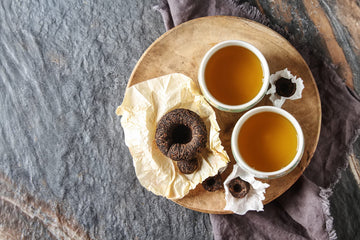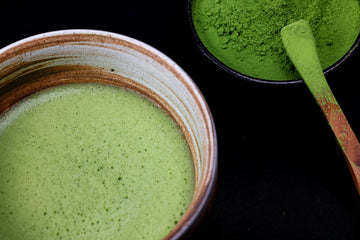Spending too much at cafés lately?
Why not bring the magic of matcha home?
Learning how to make matcha is easier than you think — and just as rewarding.
With a few simple tools and a little practice, you can create a smooth, frothy cup right in your own kitchen.
In this guide, I’ll walk you through how to choose the right matcha, how to brew it the traditional way, and how to enjoy every sip.
Let’s dive in.

Choosing the Right Matcha
Colour
Look for a bright, vivid green.
This usually means the tea leaves were shaded properly before harvest, which boosts the flavour and nutrients.
If the matcha looks yellowish or dull, it’s a sign of lower quality or older stock.

Aroma
Good matcha should smell fresh, clean, and slightly sweet.
You might have heard that the best matcha smells like seaweed — but that's not the full story.
Some matcha carries a light nori (seaweed) scent due to a method called "shading cultivation," which boosts the tea's theanine levels and can create a dimethyl sulfide aroma.
But high-quality matcha doesn’t have to smell like seaweed.
Famous brands like Marukyu-Koyamaen and Itohkyuemon offer top-grade matcha with little to no seaweed aroma, focusing instead on the tea's natural sweetness, richness, and umami.
When choosing matcha, trust your nose — a fresh, grassy, and slightly creamy scent is a good sign.
Texture and Mesh Size
The texture matters more than you might think.
Premium matcha should feel ultra-fine, almost like baby powder.
Professionally, fineness is measured by mesh size:
- Around 600 mesh: basic premium quality
- 800 mesh: excellent smoothness
- 1200 mesh: top ceremonial quality, silky texture
The finer the matcha, the smoother and creamier your cup will be.

Taste
A good matcha is smooth, rich, and naturally sweet, with a soft, lingering umami.
A slight bitterness is fine, but it should never be sharp or harsh.
Look for:
- A rich, creamy body
- A soft, sweet finish
- A clean, refreshing aftertaste
High-quality matcha leaves a gentle sweet note known as “kōmi” (甘み), coming from the tea's natural theanine, not additives.
Grade
Matcha generally falls into two main grades:
- Ceremonial grade: Smooth, sweet, and umami-rich, ideal for drinking straight.
-
Culinary grade: Stronger and more bitter, best for lattes, smoothies, and baking.
You might also see premium grade — not an official category, but often used for high-quality matcha good for daily drinking.
If drinking matcha by itself, ceremonial or premium grade is your best choice.
Organic and Ethical Sourcing
Choosing organic matcha is better for your health and supports sustainable farming.
Look for matcha sourced from trusted growers with clean cultivation practices.

What You’ll Need
You can make great matcha at home — whether you follow the traditional method or a modern shortcut.
Traditional Way
- Matcha Powder (ceremonial or premium grade)
- Bamboo Whisk (Chasen) — soak in warm water before using
- Matcha Bowl (Chawan) — wide enough for whisking
- Tea Scoop (Chashaku) — about 2g; a teaspoon works too
- Fine Sifter (recommended)
- Hot Water (75°C) — not boiling
Modern Shortcut
- Small Bowl or Mug
- Small Electric Milk Frother — blends matcha quickly
- Sifter (still recommended!)
- Good Matcha Powder + Warm Water
Step-by-Step: How to Make Matcha
Step 1: Sift the Matcha
Sift about 2g of matcha into your bowl to remove clumps and create a smoother brew.
Step 2: Add Hot Water
Pour about 40ml of hot water at 75°C over the matcha.
Avoid boiling water to preserve the delicate flavours.
Step 3: Whisk or Froth
- Traditional Way: Whisk briskly in a "W" or "M" motion to create foam.
- Modern Shortcut: Use a handheld milk frother until the surface is frothy.
Step 4: Top Up (Optional)
Add more warm water for a lighter tea (usucha) or keep it thick for a bold brew (koicha).Step 5: Enjoy Your Moment
Pause, breathe, and savour the aroma and smooth flavour.
Tips to Make Your Matcha Even Better
-
Watch Your Water Temperature
Always use water around 75°C to avoid bitterness. -
Sift Your Matcha
It takes seconds but makes a huge difference in texture. -
Whisk in a "W" Motion
Creates a lighter, even foam. -
Use the Right Amount
About 2g per cup keeps the taste balanced. -
Pick Good Matcha
Quality powder = quality tea. -
Enjoy the Moment
Matcha is as much about the experience as the flavour.
Conclusion
Making matcha at home isn’t complicated — and it’s one of the best little rituals you can add to your day.
With the right matcha, a few simple tools, and a little practice, you’ll be whisking up smooth, frothy cups in no time.Choose fresh, vibrant matcha.
Take a few extra moments to enjoy the aroma, the foam, the first sip.It’s more than just a drink — it’s a way to slow down, even for a minute.Ready to make your first bowl?
You’re only a whisk away.









